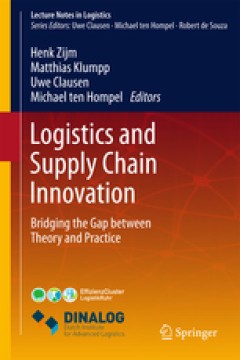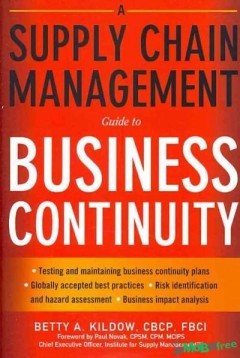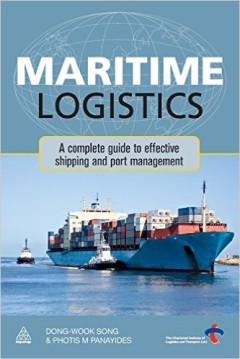Ditapis dengan

Pengembangan Sistem Logistik yang Efisien dan Efektif dengan Pendekatan Suppl…
- Edisi
- -
- ISBN/ISSN
- -
- Deskripsi Fisik
- 8 p
- Judul Seri
- -
- No. Panggil
- ATC LO DED p
- Edisi
- -
- ISBN/ISSN
- -
- Deskripsi Fisik
- 8 p
- Judul Seri
- -
- No. Panggil
- ATC LO DED p

Advocacy to Promote Logistics in Humanitarian Aid
Purpose – This paper aims to examine some of the more effective means of advocacy focused on promoting the unique role of logistics in the delivery of much needed humanitarian aid, and outlines some of the challenges as experienced in the outcomes of recent disasters such as the Indian Ocean Tsunami 2004. Design/methodology/approach – The paper draws from the limited literature availabl…
- Edisi
- Vol. 32 Iss 11 pp.
- ISBN/ISSN
- 0140-9174
- Deskripsi Fisik
- 11 p
- Judul Seri
- Management Research News
- No. Panggil
- ATC LO WHI a

A Taxonomy For Selecting Global Supply Chain Strategies
Purpose – The purpose of this paper is to address the increasingly important question of supply chain design for global operations. With the rise of off-shore sourcing and the simultaneous need for improved responsiveness to customer demand, the choice of supply chain strategy is critical. Design/methodology/approach – The paper draws its conclusions from case-based research supported b…
- Edisi
- Vol. 17 Iss 2 pp
- ISBN/ISSN
- 0957-4093
- Deskripsi Fisik
- 18 p
- Judul Seri
- The International Journal of Logistics Management
- No. Panggil
- ATC LO CHR a

The Journal Of Humanitarian Logistics and Supply Chain Management: First Refl…
Purpose – The purpose of this paper is to reflect on the editorial operations underpinning the Journal of Humanitarian Logistics and Supply Chain Management in light of the review process and the quality of articles. It further outlines the articles in the special issue and relates them to the scope of the journal. Design/methodology/approach – The editorial processes of the journal are…
- Edisi
- Vol. 1 Iss 2 pp.
- ISBN/ISSN
- 2042-6747
- Deskripsi Fisik
- 8 p
- Judul Seri
- Journal of Humanitarian Logistics and Supply Chain Management
- No. Panggil
- ATC LO KOV t

Logistics and Supply Chain Education and Jobs: A Study of UK Markets
Purpose – The purpose of this paper is to examine the curriculum design of logistics and supply chain management (LSCM) undergraduate courses offered by selected UK higher education (HE) institutions and compares them with employers’ job requirements in the UK. Design/methodology/approach – Desk-based research involving content analysis of 22 selected undergraduate LSCM courses from 1…
- Edisi
- Vol. 25 Iss 3 pp
- ISBN/ISSN
- 0957-4093
- Deskripsi Fisik
- 2014
- Judul Seri
- The International Journal of Logistics Management
- No. Panggil
- ATC LO WON l

Information Sharing In Supply Chains, Myth Or Reality? A Critical Analysis of…
Purpose – The purpose of this paper is to investigate what empirical evidence exists regarding benefits of information sharing in supply chains, and to identify potential gaps and opportunities in this research area. Design/methodology/approach – The authors conducted an in-depth, systematic literature review and multilevel analysis of 82 selected articles. In the analysis, the authors …
- Edisi
- Vol. 44 Iss 3 pp
- ISBN/ISSN
- 0960-0035
- Deskripsi Fisik
- 24 p
- Judul Seri
- International Journal of Physical Distribution & Logistics Management
- No. Panggil
- ATC LO KEM i
E-supply chain technologies and management
Today’s managers are turning to the functions of the supply chain to improve margins and gain competitive advantage. The explosion of the Internet and other e-business technologies has made real-time, online communication throughout the entire supply chain a reality. Electronic supply chain management (eSCM) is a reference to the supply chain that is structured via electronic technology-enabl…
- Edisi
- -
- ISBN/ISSN
- 978-1-59904-257-2
- Deskripsi Fisik
- xiv, 288 p.
- Judul Seri
- -
- No. Panggil
- TXT LO ESU z

Logistics Performance Measurement in The Supply Chain: A Benchmark
Purpose – The purpose of this paper is to describe the state of logistics performance measurement in corporations based in the USA. Design/methodology/approach – A triangulation approach is used, including, a Delphi study involving more than 100 practitioners, academics, and consultants identified as logistics experts; personal interviews conducted with 55 executives of 20 firms identif…
- Edisi
- Vol. 16 Iss 6 pp
- ISBN/ISSN
- 1463-5771
- Deskripsi Fisik
- 16 p
- Judul Seri
- Benchmarking: An International Journal
- No. Panggil
- ATC LO KEE l

Logistics Management and Supply Chain Management: A Critical Evaluation
The purpose of this research is to identify the content of Logistics Management and Supply Chain Management, as perceived by course instructors and textbook content, and identify the core subjects of the discipline. The study is based on review and content analysis of two samples; 30 syllabi used for teaching a basic course, and 10 textbooks that are dedicated to the discipline. A list of be…
- Edisi
- Vol. 3, No. 2
- ISBN/ISSN
- -
- Deskripsi Fisik
- 7 p
- Judul Seri
- International Journal of Business and Economics Research
- No. Panggil
- ATC LO GLO l

Logistic Service Measurement: a Reference Framework
- Edisi
- Vol. 15 Iss 3 pp.
- ISBN/ISSN
- 1741-038X
- Deskripsi Fisik
- 14 p
- Judul Seri
- Journal of Manufacturing Technology Management
- No. Panggil
- ATC LO RAF l
- Edisi
- Vol. 15 Iss 3 pp.
- ISBN/ISSN
- 1741-038X
- Deskripsi Fisik
- 14 p
- Judul Seri
- Journal of Manufacturing Technology Management
- No. Panggil
- ATC LO RAF l

A Decision-Making Model For Reverse Logistics In The Computer Industry
Purpose – This paper seeks to present a decision-making model for manufacturers to maximize their profits in reverse logistics operations. Design/methodology/approach – A system dynamic model has been developed to complement with prior models and is validated using data collected from a computer company manufacturer handling returns with volumes transacted over a period of two years. F…
- Edisi
- Vol. 17 Iss 3 pp
- ISBN/ISSN
- 0957-4093
- Deskripsi Fisik
- 27 p
- Judul Seri
- The International Journal of Logistics Management
- No. Panggil
- ATC LO TAN a

A Conceptual Framework For The Analysis Of Vulnerability in Supply Chains
- Edisi
- Vol. 30 Iss 9 pp
- ISBN/ISSN
- 0960-0035
- Deskripsi Fisik
- 27 p
- Judul Seri
- International Journal of Physical Distribution & Logistics Management
- No. Panggil
- ATC LO SVE a
- Edisi
- Vol. 30 Iss 9 pp
- ISBN/ISSN
- 0960-0035
- Deskripsi Fisik
- 27 p
- Judul Seri
- International Journal of Physical Distribution & Logistics Management
- No. Panggil
- ATC LO SVE a

Global supply chain management and international logistics
During the past 10 years, globalisation of trade has accelerated and in consequence the international environment in which we do business has changed dramatically. It is therefore not surprising that I have received numerous requests from both business executives and academics across the world to write a book on global supply chain management and international logistics and thereby fill a gap i…
- Edisi
- -
- ISBN/ISSN
- 0-203-88776-X
- Deskripsi Fisik
- xii, 167 p., ; index
- Judul Seri
- -
- No. Panggil
- TXT LO BRA g

Logistics and supply chain innovation
In today’s global economies, logistics has been recognized as one of the key factors that determine the competitive position of both individual corporations and industry-based networks. At the same time, the very nature of supply chains and supply networks is changing rapidly, as a result of both technological and social developments. These developments include advances in ICT and industrial …
- Edisi
- -
- ISBN/ISSN
- 2194-8917
- Deskripsi Fisik
- 413p
- Judul Seri
- -
- No. Panggil
- TXT LO ZIJ l

A Supply Chain management guide to business continuity
RISK MANAGEMENT, in the cloak of business continuity, must be on the radar screen of every business management team—from “top to bottom.” From planning to documentation, from risk identifi cation to hazard assessment, from global business continuity strategies to the key role of supply management, this book is full of practical, relevant, step- by- step approaches for managing the unknown…
- Edisi
- -
- ISBN/ISSN
- 978- 0- 8144- 1645-
- Deskripsi Fisik
- xiii, 261p
- Judul Seri
- -
- No. Panggil
- TXT LO KID a

Basic of supply chain management
upply Chain Management (SCM) was once a dream, a concept more than a reality, since there were many necessary components of supply chain management that could not be fully achieved. A key barrier to full supply chain management was the cost of communicating with and coordinating among the many independent suppliers in each supply chain. An entire supply chain stretches from the creation of raw …
- Edisi
- -
- ISBN/ISSN
- -
- Deskripsi Fisik
- 235p
- Judul Seri
- -
- No. Panggil
- TXT LO LAW b
Innovative Methods in Logistics and Supply Chain Management
- Edisi
- -
- ISBN/ISSN
- 978-3-8442-9880-2
- Deskripsi Fisik
- x, 577 p
- Judul Seri
- -
- No. Panggil
- TXT LO BLE i
- Edisi
- -
- ISBN/ISSN
- 978-3-8442-9880-2
- Deskripsi Fisik
- x, 577 p
- Judul Seri
- -
- No. Panggil
- TXT LO BLE i

Maritime Logistics: A Complete Guide to Effective Shipping and Port Management
Current globalization and borderless operations in manufacturing are creating a greater demand for international transportation and supply chain logistics. Maritime (shipping and ports) is one of the key components in this business pattern. It is now estimated that approximately 90% of global trading freight moves by ship. As this trade increases it is becoming more important to have a clear un…
- Edisi
- -
- ISBN/ISSN
- 978-0-7494-6369-4
- Deskripsi Fisik
- xiv, 326p. ; 24cm.
- Judul Seri
- -
- No. Panggil
- LO SON m

Improving value chain flexibility and adaptability in build-to-order environm…
Given volatile markets, the ability to quickly act is fundamental for companies – in regard to the internal production and to external supply flows in the value network. Related flexibility and adaptability concepts are vague and contradictory. Managerial methods either imply a generic application level or a narrow focus. Thus, the purpose of this paper is to develop a three-step approach to …
- Edisi
- Vol. 42 No. 4, 2012
- ISBN/ISSN
- -
- Deskripsi Fisik
- 22 p.
- Judul Seri
- International Journal of Physical Distribution & Logistics Management
- No. Panggil
- ATC LO ENG i

Establishing a framework for effective materials logistics management
The “Law of Industrial Dynamics” is a well‐known phenomenon which leads to significant swings in demand as orders are passed down along a supply chain. Large fluctuations in demand result for the manufacturer leading to policies which counteract the objectives of materials logistics management which are to reduce inventories while maintaining strategic stocks, improve product quality, min…
- Edisi
- Vol. 5 Issue: 1, pp.81-88
- ISBN/ISSN
- -
- Deskripsi Fisik
- 10 p.
- Judul Seri
- The International Journal of Logistics Management
- No. Panggil
- ATC LO NAI e

The Impact of Business Policy On Bullwhip Induced Risk In Supply Chain Manage…
Purpose – To minimise business risk of incurring increased marketability and acquisition costs due to volatile demand exacerbated by the bullwhip phenomenon. Design/methodology/approach – Based on the vision of the seamless supply chain and the active support of the decision support system exploiting the automatic pipeline inventory and order based production control system (APIOBPCS) a…
- Edisi
- Vol. 35 Iss 8 pp
- ISBN/ISSN
- 0960-0035
- Deskripsi Fisik
- 23 p
- Judul Seri
- International Journal of Physical Distribution & Logistics Management
- No. Panggil
- ATC LO TOW t

Engineering the leagile supply chain
Notes the importance of new internal supply chains being properly interfaced with the marketplace. Suggests that the appropriate way forward is to design and implement a ``leagile supply chain''. Whereas leanness may be achieved by eliminating non-value added time, agility usually requires the additional reduction of value-added time via production technology breakthroughs. Demonstrates how th …
- Edisi
- 2/1 [2000] 54±61
- ISBN/ISSN
- -
- Deskripsi Fisik
- 15 p.
- Judul Seri
- International Journal of Agile Management Systems
- No. Panggil
- ATC LO MAS e

Developing a consensus definition of supply chain management: a qualitative s…
Without the adoption of a uniform agreed upon definition of supply chain management (SCM), researchers and practitionerswill not be able to “advance the theory and practice” of the discipline. An integrated definition of SCM would greatly benefit researchers’ efforts to study the phenomenon of SCM and those practitioners attempting to implement SCM. This paper aims to address these issues.
- Edisi
- Vol. 39 No. 8, 2009
- ISBN/ISSN
- -
- Deskripsi Fisik
- 26 p.
- Judul Seri
- International Journal of Physical Distribution & Logistics Management
- No. Panggil
- ATC LO BOY d

Dyadic integration of the performance management process: A delivery service …
The purpose of this paper is to explore how to integrate the performance management (PM) process of delivery service in customer/supplier dyads.
- Edisi
- Vol. 37 No. 7, 2007
- ISBN/ISSN
- -
- Deskripsi Fisik
- 25 p.
- Judul Seri
- International Journal of Physical Distribution & Logistics Management
- No. Panggil
- ATC LO JON d

Key success factor analysis for e-SCM project implementation and a case study…
The semiconductor market exceeded US$250 billion worldwide in 2010 and has had a double-digit compound annual growth rate (CAGR) in the last 20 years. As it is located far upstream of the electronic product market, the semiconductor industry has suffered severely from the “bullwhip” effect. Therefore, effective e-based supply chain management (e-SCM) has become imperative for the efficient …
- Edisi
- Vol. 43 No. 8, 2013 pp. 657-683
- ISBN/ISSN
- -
- Deskripsi Fisik
- 29 p.
- Judul Seri
- International Journal of Physical Distribution & Logistics Management
- No. Panggil
- ATC LO PIN k

Key success factor analysis for e-SCM project implementation and a case study…
The semiconductor market exceeded US$250 billion worldwide in 2010 and has had a double-digit compound annual growth rate (CAGR) in the last 20 years. As it is located far upstream of the electronic product market, the semiconductor industry has suffered severely from the “bullwhip” effect. Therefore, effective e-based supply chain management (e-SCM) has become imperative for the efficient …
- Edisi
- Vol. 43 No. 8, 2013 pp. 657-683
- ISBN/ISSN
- -
- Deskripsi Fisik
- 29 p.
- Judul Seri
- International Journal of Physical Distribution & Logistics Management
- No. Panggil
- ATC LO NIN k

Collaborative forecasting and planning in supply chains: The impact on perfor…
The purpose of this paper is to empirically examine the impact of internal and external collaborative forecasting and planning on logistics and production performance.
- Edisi
- Vol. 39 No. 2, 2009 pp. 84-105
- ISBN/ISSN
- -
- Deskripsi Fisik
- 25 p.
- Judul Seri
- International Journal of Physical Distribution & Logistics Management
- No. Panggil
- ATC LO NAK c

Incorporating impoverished communities in sustainable supply chains
The purpose of this paper is to explore recent calls to include social and environmental considerations in supply chains by analyzing the sourcing of raw materials from impoverished communities to reduce environmental impacts and social exclusion in biofuels production.
- Edisi
- Vol. 40 No. 1/2, 2010
- ISBN/ISSN
- -
- Deskripsi Fisik
- 28 p .
- Judul Seri
- International Journal of Physical Distribution & Logistics Management
- No. Panggil
- ATC LO MAT i

Creating sustainable fresh food supply chains through waste reduction
The aim of this empirical paper is to study information sharing in fresh food supply chains, with a specific goal of reducing waste and facilitating sustainable performance. The study focuses on material and information flow issues, specifically on sharing demand and shelf-life data.
- Edisi
- Vol. 43 No. 3, 2013 pp. 262-276
- ISBN/ISSN
- -
- Deskripsi Fisik
- 17 p.
- Judul Seri
- International Journal of Physical Distribution & Logistics Management
- No. Panggil
- ATC LO LOI c

The sustainable agenda and energy efficiency: Logistics solutions and supply …
This double special issue called for logistics solutions and supply chains in times of climate change. The purpose of this editorial is to investigate the current and future implications of climate change, and in particular, energy efficiency for logistics and supply chain management (SCM).
- Edisi
- Vol. 40 No. 1/2, 2010 pp. 5-13
- ISBN/ISSN
- -
- Deskripsi Fisik
- 13 p.
- Judul Seri
- International Journal of Physical Distribution & Logistics Management
- No. Panggil
- ATC LO HAL t

Understanding integrated global sourcing
The ability to satisfy customer demands while responding to relentless competitive pressure requires creative and often complex approaches to managing a firm's supply chain. Perhaps more than any other area, executive managers increasingly believe that a concept called globalization offers the best opportunity to achieve major performance gains. One area where many companies can begin to captur…
- Edisi
- Vol. 33 Issue: 7
- ISBN/ISSN
- -
- Deskripsi Fisik
- 29 p.
- Judul Seri
- -
- No. Panggil
- ATC LO ROB u

A Simulation Approach in Supply Chain Management
- Edisi
- Vol. 13 Iss 2 pp
- ISBN/ISSN
- 0957-6061
- Deskripsi Fisik
- 8 p
- Judul Seri
- Integrated Manufacturing Systems
- No. Panggil
- ATC LO CHA a
- Edisi
- Vol. 13 Iss 2 pp
- ISBN/ISSN
- 0957-6061
- Deskripsi Fisik
- 8 p
- Judul Seri
- Integrated Manufacturing Systems
- No. Panggil
- ATC LO CHA a

Organizational alignment and supply chain governance structure
The purpose of this paper is to introduce and validate two new constructs with the potential to sharpen our understanding of how and why firms integrate their internal supply chains and assess the governance structure of their supply chains. The first construct, organizational alignment (OA), is a reflective scale measuring the extent to which upper management attempts to foster integration bet…
- Edisi
- Vol. 20 Issue: 2
- ISBN/ISSN
- -
- Deskripsi Fisik
- 20 p.
- Judul Seri
- The International Journal of Logistics Management
- No. Panggil
- ATC LO BAR o

Supply chain collaboration: what’s happening?
Collaboration has been referred to as the driving force behind effective supply chain management and may be the ultimate core capability. However, there is a fairly widespread belief tha few firms have truly capitalized on its potential. A study was undertaken to assess the current level of supply chain collaboration and identify best practice.
- Edisi
- Vol. 16 No. 2, 2005
- ISBN/ISSN
- -
- Deskripsi Fisik
- 28 p .
- Judul Seri
- The International Journal of Logistics Management
- No. Panggil
- ATC LO DAU s

Review of logistics and supply chain relationship literature and suggested re…
The paper aims to provide an overview of the evolution of relationship-related research in the areas of logistics and supply chain management.
- Edisi
- Vol. 41 No. 1, 2011
- ISBN/ISSN
- -
- Deskripsi Fisik
- 20 p.
- Judul Seri
- International Journal of Physical Distribution & Logistics Management
- No. Panggil
- ATC LO DAU r

Measuring process orientation
The purpose of this paper is to empirically develop a valid measurement scale for process orientation – a critical supply chain management (SCM) concept that warrants greater study.
- Edisi
- Vol. 20 No. 2, 2009 pp. 213-227
- ISBN/ISSN
- -
- Deskripsi Fisik
- 17 p.
- Judul Seri
- The International Journal of Logistics Management
- No. Panggil
- ATC LO TIA m

Outsourcing of integrated logistics functions- An examination of industry pra…
A survey of 372 logistics managers in different industries revealed multiple outsourcing linkages among logistics activities. These results are consistent with previous findings that suggest that firms can improve customer service and reduce costs by outsourcing multiple logistics functions. The results are also consistent with previous research on the role that improved coordination of informa…
- Edisi
- Vol. 29 Issue: 6
- ISBN/ISSN
- -
- Deskripsi Fisik
- 25 p .
- Judul Seri
- International Journal of Physical Distribution & Logistics Management
- No. Panggil
- ATC LO DRE o

Performance measurements in the greening of supply chains
In response to increasing demands on improved environmental performance, companies need to develop their capabilities in assessing the environmental performance of their operations. Knowledge among practitioners as well as solid research results in this area is lacking. This paper aims to present a framework of dimensions, which are important to consider regarding environmental measurement in s…
- Edisi
- Volume 17 · Number 1 · 2012 · 29–39
- ISBN/ISSN
- -
- Deskripsi Fisik
- 14 p.
- Judul Seri
- Supply Chain Management: An International Journal
- No. Panggil
- ATC LO ABR p

Linking strategic logistics change to labor rights
This paper aims to describe how research literature and logistics practitioners respectively describe the link between logistics and corporate social responsibility, focusing on the link between strategic logistics change (location, capacity and number of facilities as well as the design of supplier and customer network) and labor rights.
- Edisi
- Vol. 6 Issue: 4, pp.580-592
- ISBN/ISSN
- -
- Deskripsi Fisik
- 15 p.
- Judul Seri
- Social Responsibility Journal
- No. Panggil
- ATC LO BJO l

The purpose and focus of environmental performance measurement systems in log…
Environmental performance measurement systems (EPMS) in supply chains are increasingl important.The aim of this paper is to investigate the purposes of having an EPMS in logistics and inwhat ways the purpose of an EPMS can influence its focus in the supply chain.
- Edisi
- Vol. 62 No. 3, 2013 pp. 230-249
- ISBN/ISSN
- -
- Deskripsi Fisik
- 22 p.
- Judul Seri
- International Journal of Productivity and Performance Management
- No. Panggil
- ATC LO FOR t

Major business-environment influences on the cereal products industry supply …
The purpose of the paper is to provide a contextual basis for the supply chain activity of the generic Australian cereal products supply chain. It identifies the business-environment factors underpinning the cereal products supply chain efficiency. It also further highlighted the complex nature of the extended supply chain and all the factors to be considered in its management. The approach to …
- Edisi
- Vol. 36 No. 1, 2006
- ISBN/ISSN
- -
- Deskripsi Fisik
- 17 p.
- Judul Seri
- International Journal of Physical Distribution & Logistics Management
- No. Panggil
- ATC LO PER m

Managing risks in the supply chain using the AHP method
The aim of the research is to provide a method to evaluate supply chain risks that stand in the way of the supply chain objectives.
- Edisi
- Vol. 17 No. 1, 2006
- ISBN/ISSN
- -
- Deskripsi Fisik
- 29 p.
- Judul Seri
- The International Journal of Logistics Management
- No. Panggil
- ATC LO BOR m

Managing the product design-supply chain interface: Towards a roadmap to the …
The purpose of this paper is to investigate the interface between product design and the supply chain and to develop a roadmap to the design centric business through better management of this interface.
- Edisi
- Vol. 39 No. 4, 2009
- ISBN/ISSN
- -
- Deskripsi Fisik
- 22 p.
- Judul Seri
- International Journal of Physical Distribution & Logistics Management
- No. Panggil
- ATC LO CRE m

Managing complexity in agile global fashion industry supply chains
The purpose of this paper is to examine the agile supply chain management practices adopted by UK clothing retailers in order to effectively manage the supply of innovative, high-margin, high-fashion content product offerings in a complex global environment.
- Edisi
- Vol. 18 No. 2, 2007
- ISBN/ISSN
- -
- Deskripsi Fisik
- 21 p .
- Judul Seri
- The International Journal of Logistics Management
- No. Panggil
- ATC LO FER m

How Australian manufacturing firms perceive and understand the concepts of ag…
The purpose of this paper is to address an important question which centres on investigating how do manufacturing businesses perceive and understand the concepts of agility and flexibility in their supply chains (SCs).
- Edisi
- Vol. 35 No. 2, 2015 pp. 246-281
- ISBN/ISSN
- -
- Deskripsi Fisik
- 39 p.
- Judul Seri
- International Journal of Operations & Production Management
- No. Panggil
- ATC LO LOU h

The efficiency of European container terminals and implications for supply ch…
This paper investigates the efficiency of container terminals within the context of global supply chain management. The efficiency and scale properties of 104 of Europe’s container terminals with annual throughput of over 10,000 TEUs1 in 2003, distributed across 29 European countries, are derived using data envelopment analysis. The main findings are that significant inefficiency pervades mos…
- Edisi
- -
- ISBN/ISSN
- -
- Deskripsi Fisik
- 18 p.
- Judul Seri
- Maritime Economics & Logistics
- No. Panggil
- ATC LO CUL t

Productivity improvement of a computer hardware supply chain
To determine the key reverse logistics variables, which the top management should focus so as to improve the productivity and performance of computer hardware supply chains.
- Edisi
- Vol. 54 No. 4, 2005 pp. 239-255
- ISBN/ISSN
- -
- Deskripsi Fisik
- 22 p.
- Judul Seri
- International Journal of Productivity and Performance Management
- No. Panggil
- ATC LO RAV p

Reverse logistics programs: gauging their effects on CRM and online behavior
To provide practitioners of knowledge management with a sense of the importance of reverse logistics as an important part of today’s company policies, especially throughout the product life cycle, with the accompanying technology that supports it and the effects on customer relation management (CRM) and satisfaction.
- Edisi
- Vol. 35 No. 3, 2005
- ISBN/ISSN
- -
- Deskripsi Fisik
- 18 p.
- Judul Seri
- VINE
- No. Panggil
- ATC LO SMI r

Supply chain implications for one-off luxury products: cases from the yacht i…
The paper seeks to investigate the applicability of strategic supply chain management (SCM) models in one-off luxury contexts such as the yacht industry, where durable products are manufactured with project configuration.
- Edisi
- Vol. 41 No. 11/12, 2013
- ISBN/ISSN
- -
- Deskripsi Fisik
- 23 p.
- Judul Seri
- International Journal of Retail & Distribution Management
- No. Panggil
- ATC LO DUL s

Services for distribution of tissue engineering products and therapies
Tissue engineering (TE) offers treatments for chronic, life threatening, degenerative illnesses and possibilities for restoring cellular or organ functions that have been lost due to injuries or hereditary conditions. However, a prerequisite for the use of TE products as part of future therapies is the development of strategies for safe and efficient supply chain management and versatile servic…
- Edisi
- Vol. 58 No. 1, 2009 pp. 11-28
- ISBN/ISSN
- -
- Deskripsi Fisik
- 20 p.
- Judul Seri
- International Journal of Productivity and Performance Management
- No. Panggil
- ATC LO NOR s
 Karya Umum
Karya Umum  Filsafat
Filsafat  Agama
Agama  Ilmu-ilmu Sosial
Ilmu-ilmu Sosial  Bahasa
Bahasa  Ilmu-ilmu Murni
Ilmu-ilmu Murni  Ilmu-ilmu Terapan
Ilmu-ilmu Terapan  Kesenian, Hiburan, dan Olahraga
Kesenian, Hiburan, dan Olahraga  Kesusastraan
Kesusastraan  Geografi dan Sejarah
Geografi dan Sejarah